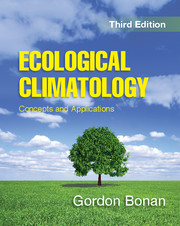Book contents
- Frontmatter
- Dedication
- Contents
- Preface
- 1 Ecosystems and Climate
- Part I The Earth System
- Part II Global Physical Climatology
- 4 Atmospheric Radiation
- 5 Atmospheric General Circulation and Climate
- 6 Earth's Climates
- 7 Climate Variability
- 8 Climate Change
- Part III Hydrometeorology
- Part IV Biometeorology
- Part V Terrestrial Plant Ecology
- Part VI Terrestrial Forcings and Feedbacks
- Appendix
- Index
- Plate section
- References
8 - Climate Change
from Part II - Global Physical Climatology
Published online by Cambridge University Press: 05 November 2015
- Frontmatter
- Dedication
- Contents
- Preface
- 1 Ecosystems and Climate
- Part I The Earth System
- Part II Global Physical Climatology
- 4 Atmospheric Radiation
- 5 Atmospheric General Circulation and Climate
- 6 Earth's Climates
- 7 Climate Variability
- 8 Climate Change
- Part III Hydrometeorology
- Part IV Biometeorology
- Part V Terrestrial Plant Ecology
- Part VI Terrestrial Forcings and Feedbacks
- Appendix
- Index
- Plate section
- References
Summary
Chapter Summary
Climate has changed over the course of Earth's history and will change in the future. Just 18,000 years before present (18 kyr BP), Earth was in the grips of a prolonged cold period in which ice covered vast tracts of the Northern Hemisphere. Over the past few million years there have been numerous such ice ages separated by shorter, warm interglacial periods. The geologic record also reveals numerous rapid climate changes over periods as short as decades or centuries. This climate change is the result of changes in the external forcing of the Earth system by the Sun and internal physical, chemical, and biological feedbacks among the atmospheric, oceanic, and terrestrial components of the Earth system. Plate tectonics and changes in the geometry of Earth's orbit around the Sun influence climate at timescales of millennia or longer. Changes in the concentration of greenhouse gases or in the runoff of freshwater to oceans affect climate at timescales of centuries to millennia. Changes in solar irradiance or volcanic eruptions that emit aerosols into the atmosphere influence climate at timescales of years to decades. Climate change over the twentieth and twenty-first centuries is reviewed in the context of greenhouse gases and anthropogenic influences on climate.
Glacial Cycles
Over the past several hundred thousand years, glaciers have cyclically advanced and retreated in the Northern Hemisphere with a period of about 100 kyr. Glaciation typically takes 90 kyr to complete while deglaciation occurs over 10 kyr. Ice cores extracted deep below the surface in Greenland and Antarctica record Earth's climate history and reveal these ice ages. Atmospheric gases trapped in ice as glaciers grow provide a record of the temperature and chemical composition of the atmosphere at the time the ice formed. A 2,755-m deep record of the Vostok ice core extracted from Antarctica illustrates climate change over the past 250 kyr BP. The record shows two distinct cold periods beginning about 190 kyr BP and lasting until 140 kyr BP and again beginning about 115 kyr BP until 18 kyr BP (Figure 8.1). During these glacial periods, temperature was several degrees colder than present. The record also shows two warm periods following these ice ages from about 140 kyr to 125 kyr BP and presently beginning about 15 kyr BP.
- Type
- Chapter
- Information
- Ecological ClimatologyConcepts and Applications, pp. 117 - 140Publisher: Cambridge University PressPrint publication year: 2015



